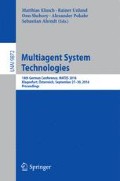Abstract
When the situation involves artificial and natural agents in the same environment that work together to achieve joint goals we talk about cooperative activities, human-agent teamwork, joint activities, or joint human-agent activities. Although, teamwork has become a widely accepted metaphor for multi-robot/multi-agent cooperation there are several challenges towards making agents “teammates” – some of them are present independently from the teams mixture, whereas others are particularly challenging for the development of human-agent teams. This work presents an overview about the challenges and brings together knowledge from the different involved research areas, further, we provide an attempt to define the term joint human-agent activity in order to motivate a discussion about the necessary elements.
Access this chapter
Tax calculation will be finalised at checkout
Purchases are for personal use only
Notes
- 1.
Thus, the shared goal is a synonym to the prior introduced joint goal.
References
Ahrndt, S., Fähndrich, J., Albayrak, S.: Human-agent teamwork: what is predictability, why is it important? In: SAC 2016, pp. 284–286. ACM Press (2016)
Baarslag, T., Hendrikx, M.J., Hindriks, K.V., Jonker, C.M.: Learning about the opponent in automated bilateral negotiation: a comprehensive survey of opponent modeling techniques. Auton. Agent Multi Agent Syst. pp. 1–50 (2015)
Bradshaw, J.M., Feltovich, P., Johnson, M., Breedy, M., Bunch, L., Eskridge, T., Jung, H., Lott, J., Uszok, A., van Diggelen, J.: From tools to teammates: joint activity in human-agent-robot teams. In: Kurosu, M. (ed.) HCD 2009. LNCS, vol. 5619, pp. 935–944. Springer, Heidelberg (2009)
Bratman, M.E.: Shared cooperative activity. Philos. Rev. 101(2), 327–341 (1992)
Brennan, S.E.: The grounding problem in conversations with and through computers. In: Fussell, S., Kreuz, R. (eds.) Social and Cognitive Psychological Approaches to Interpersonal Communicaton, pp. 201–225. Lawrence Erlbaum Associates, Hillsdale (1998)
Christoffersen, K., Woods, D.D.: How to make automated systems team players. Adv. Hum. Perform. Cogn. Eng. Res. 2, 1–12 (2002)
Cirillo, M., Karlsson, L., Saffiotti, A.: Human-aware planning for robots embedded in ambient ecologies. Pervasive Mob. Comput. 8, 542–561 (2012)
Clark, H.H.: Using Language. Cambridge Univ. Press, Cambridge (1996)
Cohen, P.R., Levesque, H.J., Smith, I.: On team formation. In: Holmstrom-Hintikka, G., Tuomela, R. (eds.) Contemporary Action Theory, Synthese, vol. 2, pp. 87–114. Social Action (1997)
Grosz, B.J., Kraus, S.: Collaborative plans for complex group actions. Artif. Intell. 86(2), 269–357 (1996)
Hoffman, G., Breazeal, C.: Effects of anticipatory action on human-robot teamwork – efficiency, fluency, and perception of team. In: HRI 2007, pp. 1–8. ACM Press (2007)
Jennings, N.R.: Commitments and conventions: the foundation of coordination in multi-agent systems. Knowl. Eng. Rev. 8(3), 223–250 (1993)
Joe, J.C., O’Hara, J., Medema, H.D., Oxstrand, J.H.: Identifying requirements for effective human-automation teamwork. In: PSAM 12 (2014)
Johnson, M., Bradshaw, J.M., Feltovich, P.J., Jonker, C.M., van Riemsdijk, B., Sierhuis, M.: The fundamental principle of coactive design: interdependence must shape autonomy. In: Vos, M., Fornara, N., Pitt, J.V., Vouros, G. (eds.) COIN 2010. LNCS, vol. 6541, pp. 172–191. Springer, Heidelberg (2011)
Johnson, M., Bradshaw, J.M., Feltovich, P.J., Jonker, C.M., van Riemsdijk, B., Sierhuis, M.: Autonomy and interdependence in human-agent-robot teams. IEEE Intell. Syst. 27(2), 43–51 (2012)
Johnson, M., Bradshaw, J.M., Feltovich, P.J., Jonker, C.M., van Riemsdijk, M.B., Sierhuis, M.: Coactive design: designing support for interdependence in joint activity. J. Hum. Rob. Interact. 3(1), 43–69 (2014)
Klein, G., Feltovich, P.J., Bradshaw, J.M., Woods, D.D.: Common ground and coordination in joint activitiy. In: Rouse, W.B., Boff, K.R. (eds.) Organizational Simmulation, Chap. 6, pp. 139–184 (2005)
Klein, G., Woods, D.D., Bradshaw, J.M., Hoffmann, R.R., Feltovich, P.J.: Ten challenges for making automation a “team player” in joint human-agent activity. Hum. Centered Comput. 19(6), 91–95 (2004)
Lin, R., Kraus, S.: Can automated agents proficiently negotiate with humans? Commun. ACM 53(1), 78–88 (2010)
Myers, K.L., Morley, D.N.: Human directability of agents. In: K-CAP 2001, pp. 108–115. ACM Press (2001)
Rosenthal, S., Biswas, J., Veloso, M.: An effective personal mobile robot agent through symbiotic human-robot interaction. In: AAMAS 2010, pp. 915–922 (2010)
Sycara, K., Sukthankar, G.: Literature review of teamwork models. Technical report CMU-RI-TR-06-50, Robotics Institute, Pittsburgh, PA (2006)
Sycara, K.P., Lewis, M.: Integrating intelligent agents into human teams. In: Salas, E., Fiore, S. (eds.) Team Cognition: Understanding the Factors that Drive Process and Performance, pp. 1–36. American Psychological Association, March 2004
Author information
Authors and Affiliations
Corresponding author
Editor information
Editors and Affiliations
Rights and permissions
Copyright information
© 2016 Springer International Publishing Switzerland
About this paper
Cite this paper
Ahrndt, S., Albayrak, S. (2016). Joint Human-Agent Activities: Challenges and Definition. In: Klusch, M., Unland, R., Shehory, O., Pokahr, A., Ahrndt, S. (eds) Multiagent System Technologies. MATES 2016. Lecture Notes in Computer Science(), vol 9872. Springer, Cham. https://doi.org/10.1007/978-3-319-45889-2_8
Download citation
DOI: https://doi.org/10.1007/978-3-319-45889-2_8
Published:
Publisher Name: Springer, Cham
Print ISBN: 978-3-319-45888-5
Online ISBN: 978-3-319-45889-2
eBook Packages: Computer ScienceComputer Science (R0)

